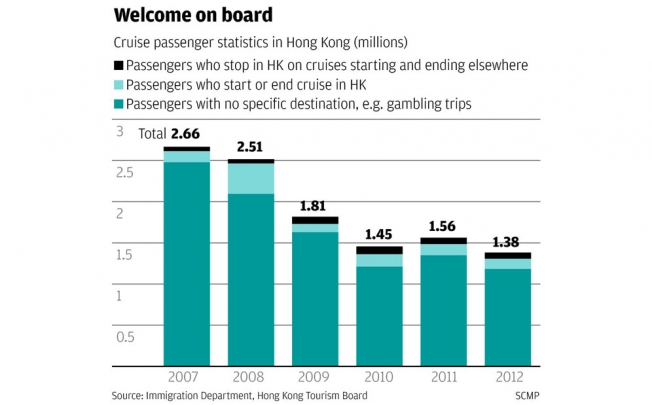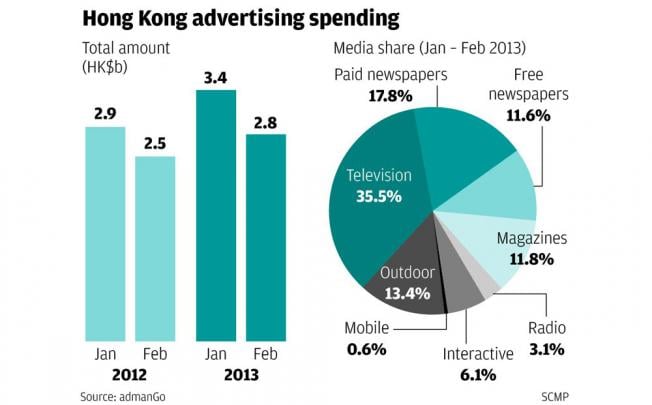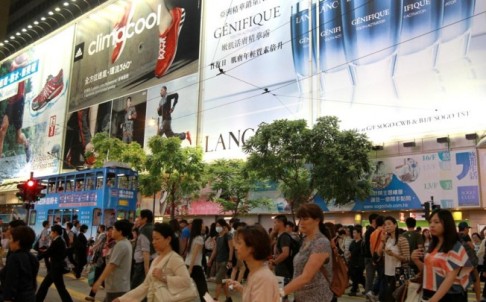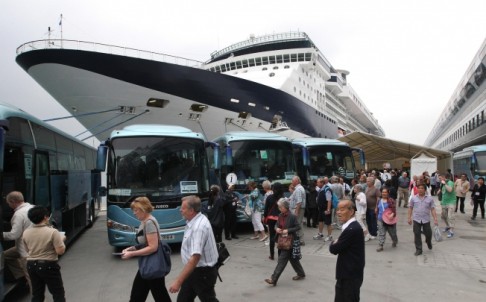Hong Kong Advertising - Adwater
The Adwater boat provides billboard advertising on Victoria Harbour in Hong Kong, one of the busiest and most photographed harbours in the world. Your brand and advertising campaign are showcased to hundreds of thousands of tourists, business travellers and locals each day. Adwater provides the most unique and effective out of home advertising available in Hong Kong.
Sai Ying Pun - New Site
Adwater is pleased to announce its latest advertising opportunity situated at the corner of High Street and the Centre Street Escalator, Sai Ying Pun. This unique site has been chosen so that clients can take advantage of this fast developing district, and increased traffic flow from the new MTR station opening in Q1 2015.
Digital Screen Advertising in Hong Kong Shopping Malls
Adwater is now offering clients access to 50 digital screens across 10 Link Shopping Malls in Hong Kong. Advertisers can place media in 10 second intervals with a maximum of 5 advertising spots available, the sixth spot being reserved for shopping mall services.
With a footfall of over 11 million shoppers and commuters a month, this is a lucrative new medium to showcase your brand and advertising campaigns.

With a footfall of over 11 million shoppers and commuters a month, this is a lucrative new medium to showcase your brand and advertising campaigns.
Advertising revenues in Hong Kong on the rise
HONG KONG: Advertising expenditure in Hong Kong rose 8% during August, with spending on campaigns for mooncakes, the traditional delicacy of the Mid-Autumn Festival, up an estimated 43%, new figures have shown.
Data from media spending analyst admanGo, reported in the South China Morning Post, indicated that adspend reached HK$3.61m, with advertising on mooncakes amounting to HK$63m.
"Mooncake brands advertised aggressively this year," noted admanGo, although most of the month's increase was attributable to marketing campaigns from banking and investment services, cosmetics and skincare, pharmaceuticals and healthcare, toiletries and household, and beverage industries.
Paid newspapers took a 16% share of Hong Kong's total advertising spending last month, behind television's 30%, but certain sectors, including sports, car and petroleum, restaurant, beverage and insurance, preferred paid newspapers for their campaigns.
In mainland China, however, the holiday picture was more gloomy. Sales of mooncakes, for example, fared worse as press agency Xinhua noted that the more upmarket versions had become "less of a food and more of a tool to bribe officials or business partners".
But with the government's crackdown on corruption, including a specific instruction to cut back on giving gifts or holding banquets using public funds around festivals, sales have dropped dramatically.
For example, Chaoshifa, a major supermarket chain in Beijing, saw a 60% year-on-year decline in group buying of packaged mooncake by companies, government agencies or other organizations, according to figures released by the Beijing Municipal Commission of Commerce.
And in Qingdao, a major seaside holiday destination in northern China, China Economic Review related how the consumption for moon cakes, cigarettes and spirits fell by 10% compared to last year.
The upcoming Golden Week holiday, starting on October 1 is unlikely to bring much relief to retailers or tour operators, as the government has banned "forced shopping", whereby tour operators are able to offer cheap package deals while collecting commissions from the shops they take tour groups to.
As a result tour group numbers to Hong Kong from mainland China are expected to fall by as much as 30%.
Data sourced from South China Morning Post, Xinhua, China Economic Review; additional content by Warc staff, 25 September 2013
The countdown is on!
The Adwater boat has signs on both sides and is close to being ready for ad space bookings. Not long now!
Technology vs Paper
Technology is fast replacing the world's need for paper, but not for everything!
Ad campaigns remained healthy in April - Hong Kong Advertising
Ad campaigns remained healthy in April
Wednesday, 22 May, 2013, 4:03am
Bien Perezbien.perez@scmp.com
Hong Kong's advertising market posted a 12 per cent year-on-year gain in April despite reduced spending by some key industries.
Media-monitoring firm admanGo yesterday said in a report that advertising expenditure last month advanced to HK$3.37 billion from HK$3 billion a year earlier, even as campaigns for the food, entertainment, retail as well as jewellery, watch and luxury product categories slowed.
"Without festive holidays to boost sales, advertisers spent less on launching campaigns during April," admanGo's director of sales and marketing, Jennifer Ma, said. But other industries such as the cosmetics and skincare segment apparently boosted marketing initiatives.
For the four months to March, advertising spending climbed to HK$13 billion from HK$11.6 billion the previous year.
Television, newspapers, magazines, outdoor media and radio cornered 92 per cent of the advertising campaigns last month.
"Newspapers stood out with a 20 per cent year-on-year increase [in advertising sales], the highest among traditional media," Ma said.
Advertising on mobile had a 1 per cent share of total spending last month, while online platforms seized a 7 per cent share.
The cosmetics and skincare industry was the No1 advertising segment for the third consecutive month this year, according to admanGo. This sector, which was ranked second a year ago, raised its spending 41 per cent to HK$338 million.
Banking and investment services, the No2 advertising segment, boosted its spending on campaigns 15 per cent to HK$308 million, led by HSBC.
The leading advertiser last month was Procter & Gamble (P&G), which also led the market in the first quarter. The American multinational consumer goods company posted an 87 per cent increase in expenditure to HK$102 million.
Brands under P&G included Olay, Head & Shoulders, Whisper, Pampers, Gillette and Duracell.
For the second consecutive month, L'Oreal was the No2 advertiser behind P&G. The Paris-based company, the world's largest supplier of cosmetics and beauty products, grew spending 61 per cent to HK$78 million.
Its portfolio of brands included Lancome, Kiehl's and Shu Uemura.
Adidas really went over the top with this billboard campaign
We like the impact of this campaign by Adidas. There is absolutely no way you can miss it!
Speak now or forever hold your peace!
This one from TNT Drama channel. We agree, this scene looks like it's about to create drama!
Kevin Rudd keeps on truckin
This billboard on the side of a semi-trailer congratulates Kevin Rudd on once again becoming Australia's Prime Minister
First day of the sale season - ready to fight!
This ad from Harvey Nichols - Ever been to the first day of a sale?
Slip Slop Slap!
We like this clever billboard for its creativity and important message

And if you weren't brought up in Australia, this ad is what the reference to Slip Slop Slap is all about, an old but effective campaign from the 1980s.
The Adwater Boat route goes past the new cruise terminal in Hong Kong everyday showcasing advertisements to thousands of passengers onboard visiting ships.
For decades, low-flying jets approaching Kai Tak airport, thundering over the heads of residents in Kowloon City, were a unique if noisy feature of old Hong Kong.
 The airport, with its single runway jutting into the harbour at a hair-raising angle to Lion Rock, was regarded as one of the toughest landings for even the most experienced pilots. Its closure in 1998 marked the end of the Kai Tak era as the city's transportation hub. The land remained bare save for a few temporary buildings for much of the next decade.
The airport, with its single runway jutting into the harbour at a hair-raising angle to Lion Rock, was regarded as one of the toughest landings for even the most experienced pilots. Its closure in 1998 marked the end of the Kai Tak era as the city's transportation hub. The land remained bare save for a few temporary buildings for much of the next decade.
But while the roar of low-flying jets is a thing of the past, passengers' luggage is returning to the area as it once again becomes a centre for transport and tourism .
Built at a cost of HK$8.2 billion, the Kai Tak Cruise Terminal finally welcomed its first visitors yesterday after years of planning and construction. Carrying more than 3,000 passengers and making her maiden voyage to Hong Kong, the 310-metre, 15-deck Mariner of the Seas would have been too big to berth at Ocean Terminal in Tsim Sha Tsui.
The government is pinning its hopes on the cruise terminal to boost tourism and help revitalise the eastern end of Kowloon, for which it has ambitious plans.
But questions remain about the wisdom of the project. Will the terminal ever be full? Will passengers and cruise operators want to dock in Kowloon Bay, far from the centre of the city and with limited public transport, at least for the time being? And can Hong Kong attract enough passengers to justify the huge investment and use of scarce land?
The cruise terminal can accommodate the largest cruise ships in the world, of up to 220,000 gross tonnes, the size of Royal Caribbean's Allure of the Seas. The facility boasts customs and immigration halls that can clear 3,000 passengers an hour, a massive car park for hundreds of vehicles, and a 23,000-square-metre landscaped deck, one of the largest public roof gardens in Hong Kong. Columnless waiting halls can be converted into exhibition and convention venues outside the peak cruise season.
But for the first 10 months of operations, until next April, the terminal has just 20 bookings for a total of 30 days of berth occupancy, meaning the one berth that is open so far will be empty far more frequently than it is full.
The government and the terminal's operator say that is no reason to worry. They say it takes international cruise lines about 18 months to make adjustments to the deployment of vessels around the globe, meaning the bookings will rise only gradually.
Between 2007 and last year, the total number of cruise passengers passing through or beginning or ending their journeys in Hong Kong declined sharply by 48 per cent to 1.38 million. Most of that was due to a 52 per cent fall in the number of passengers taking cruises with no other destination - gambling cruises that sail to international waters where players can bet legally before returning to port.

Excluding the gambling cruises, the number of passengers rose six per cent. Transit passengers - those who start and end their cruises elsewhere - were up 42 per cent, but the total remained small at 77,536 last year. The number who started or ended their cruise in the city dipped 8 per cent to 121,000.
Hongkongers seem to have lost their sea legs. The number of them who joined multi-city cruises that passed through the city fell by 68 per cent to 15,000 per year during the same period.
And while destinations around the world are cashing in on the growth in mainland tourism, few are taking cruises featuring a Hong Kong stop. Their numbers increased just 4.4 per cent to 28,137 in the five years to 2012, a time when the number of mainland visitors to Hong Kong increased from 15.5 million a year to 34.9 million.
The latter figure goes some way to explaining why the city is so keen to invest in cruise facilities - it's a way to diversify its source of tourists, providing a hedge against a future drop in mainland visitors and strengthening its reputation as "Asia's world city".
Indeed, the number of Australians passing through Hong Kong on ships in the five years to 2012 more than doubled to 34,465 in the six years to last year. The number of American and European cruise visitors also rose, by 17 per cent and 12 per cent respectively.
A much bigger incentive for investment is the "Asian dream" promoted by the cruise industry, which sees the region as its next big frontier. With more cruise lines deploying vessels to Asia to tap into the rapidly growing market, Hong Kong must join the race or miss the opportunity, tourism industry executives say.
According to industry website Cruise Market Watch, the global cruise industry is projected to grow at an annual compounded rate of 7.4 per cent to 22.4 million cruise passengers by 2015.
Pier Luigi Foschi, chairman of the Asian arm of the world's biggest cruise company, Carnival, expects the total number of cruise passengers in Asia to reach as many as 3.7 million by 2017 and then increase to more than seven million by 2020.
"There's a lot of work to do to make this a reality. In 2013, Asia represented just under 5 per cent of total allocated beds for us, which is in line with the overall Cruise Lines International Association figures for their major member lines," said William Harber, vice president of market development for Carnival Asia.
At present, the 34 per cent of the cruise market is the Caribbean, 29 per cent in the Mediterranean and 10 per cent in Europe outside of the Mediterranean.
Carnival's Costa brand has doubled its capacity in Asia, while its Princess line will be bringing its ship Sapphire Princess to the region next year to join her sister ships Diamond and Sun.
Royal Caribbean Cruises, the second-largest cruise company and one of the partners operating the Kai Tak terminal, also has high hopes for the region.
"We started full-year deployment in Asia in 2010. Before that, we had seasonal sailings instead of year-round deployment," managing director for China Dr Liu Zinan said.
Two vessels, Legend of the Seas and Voyager of the Seas, were in Asia last year. Legend was replaced by the larger Mariner of the Seas this year, and the vessel will embark on round trips from Hong Kong to Taiwan this autumn.
The approach to vacationing in Asia is changing, Liu says. Sightseeing and shopping were the main reasons to holiday in the past, but more and more people recognise cruising as an option for leisure travel.
"My expectation is that China and Asia will become the second-largest source market, surpassing Europe and coming after the United States," he said. By the end of this year, about 500,000 Chinese passengers will be starting or ending a cruise trip in their home country, Liu added.
In the long run, regional growth is guaranteed by upgrades to infrastructure across the board, he said. In Japan, local governments are expanding port capacity. In South Korea, a new terminal will open in Busan in 2015.
New terminals have already opened in Tianjin and Shanghai in 2010 and 2011, but they are not competing for guests with Hong Kong, he said.
The two ports target northern and eastern provinces respectively, while Hong Kong aims at the southern market, including Guangzhou and Shenzhen.
"Each market is big enough… and about the size of Australia in terms of population," he said. "Hong Kong itself is also an important market. And having the city in the itinerary will attract international guests."
Liu has been encouraged by promises from the central government to help mainland passengers secure the visas they need, allowing cruise firms to offer more flexible itineraries.
In the past, mainland cruise passengers sailing from Hong Kong could go only as far as Taiwan. But under the Closer Economic Partnership Arrangement signed last year, authorities have promised to allow Japan and South Korea to be included in itineraries.
The promise has yet to materialise, as cruises from China to Japan came to a halt due to the territorial dispute over the Diaoyu Islands, which Japan calls the Senkakus.
For signs of how it could benefit from the Asian cruise boom, Hong Kong can look to the example of Singapore, which opened a new cruise terminal at Marina Bay last year.
From 2003 to last year, its cruise passenger throughput grew by an annual compound rate of 6.5 per cent to 913,000. While the number of ship visits fell from 717 in 2007 to 394 in 2012 as gaming ship operations were terminated, the Southeast Asian island state is hoping that bigger ships arriving at its new terminal will bring in more high-spending tourists.
The new terminal already serves as the home port for ships cruising to Malaysia and Thailand. The number of ships making their first visit to the city more than tripled from three in the year before the new terminal opened to 11 in the year since, said Edward Chew Chin-heng, the Singapore Tourism Board's regional director for Greater China.
The key to attracting cruise lines to make a city their home is prove to them it is a viable business decision, he said.
Maintaining healthy local demand for cruises is essential - 40 per cent of passengers are Singaporeans, Chew says.
The government should promote cruise tourism in potential source markets and constantly develop new itineraries, he adds. A sub-group under the Association of Southeast Asian Nations is responsible for co-ordinating Southeast Asian ports, he said.
"We are hopeful that Southeast Asia will be the new Caribbean and Mediterranean. What we are particularly excited about is the diversity of cultures and landscapes. That makes a good itinerary," he said.
Investing in the cruise sector is a long-term and continual commitment. Singapore has reserved space for more berths at Marina Bay if necessary, he adds.
Apart from tourism receipts, more cruise vessels also mean more business for shipyards, he says. One Singaporean yard received 12 orders for refits and servicing in the first few months of the terminal's operation, twice as many as the entire previous year.
The competition between Hong Kong and Singapore is not a zero-sum game, Chew says: "We've got to have more than one destination… we are part of the same product."
Singapore would like to co-operate with Hong kong to train tour agents responsible for excursions, and to promote cruising as a viable option of travel in Asia, Chew said.
IBM Out-Of-Home advertising takes Billboards to a new level
Nice work IBM. Media providers have been supplying street furniture like bus stops to cities for years. They do this of course so they can claim rights to lucrative ad space on the furniture. This campaign by IBM however actually makes street furniture out of the ads!
We particularly like the use of a ramp which is not only useful for wheeling luggage up stairs like you see in the picture, we like the fact it can be used by people in wheelchairs too.
What is the cost of advertising in Hong Kong?
Advertising rates in Hong Kong can vary depending on the media provider and type of advertisement. It is possible to advertise on buses, trams, ferries, billboards, coffee cups and in newspapers. Advertising rates can from HKD$40 000 per month for a small billboard on the Midlevels escalator to over HKD$1 Million per month for large billboards on buildings around Central and Causeway Bay.

Putting the spotlight on sustainable electricity use
This billboard promotes energy efficiency as much as it does the electricity company that placed the ad. We like its clever use of spotlighting to promote a sustainability message.
Heil JC Penney
This unfortunate billboard placed by JC Penney advertising a tea pot kind of resembles Hitler!
Walking Dead - Dead Wrong Ad Placement!
Oh dear, spot anything wrong with this billboard placement? Clear Channel Advertising, the firm who placed the ad released a statement saying, "We apologize for any offense caused by the unfortunate juxtaposition of this ad. It was certainly not intended. We have arranged to have it moved right away."
Dove Real Beauty Ad and.... the Parody!
Ah I guess this had to happen, Dove's Real Beauty Campaign featuring women describing themselves as less beautiful than they really are and then, the male version. Check them both out!
Hong Kong Ad Spending Soars
According to admanGo's figures, driven by the shopping peak season of the Chinese New Year, Hong Kong saw its overall advertising expenses shoot up 15% year-on-year in the first two months of 2013, reaching a total of HK$6.21 billion.

Real-Time Weather Report
We like this ad from the Met Service in New Zealand, it's a billboard that provides real-time weather! Very clever indeed.
Ship your pants at Kmart and the US Navy
This ad from Kmart is a crack up! Great word play.
3 U.S. naval ships make port call in Hong Kong
(Xinhua)
From People's Daily Online - We like how the ad on the Tsim Sha Tsui building has shown up in the background of this photo. Tsim Sha Tsui on Hong Kong's Victoria Harbour is along the route of the Adwater Boat which places your brand in front of hundreds of thousands of tourists, business travellers and locals each day. Click here to read this article.
Subscribe to:
Comments (Atom)





.jpg)

